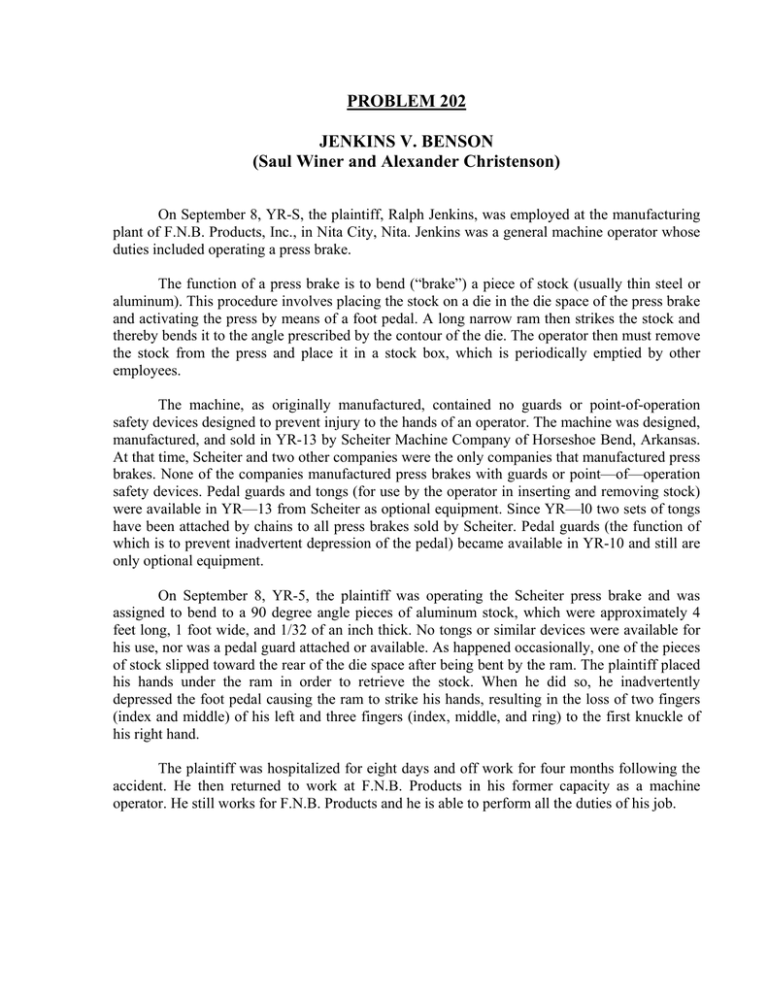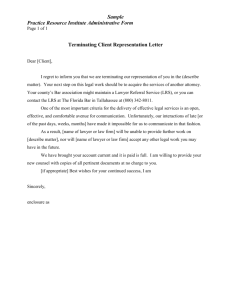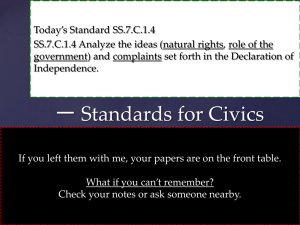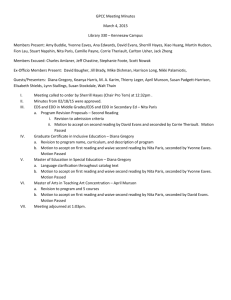PROBLEM 202 JENKINS V. BENSON (Saul Winer and Alexander Christenson)
advertisement

PROBLEM 202 JENKINS V. BENSON (Saul Winer and Alexander Christenson) On September 8, YR-S, the plaintiff, Ralph Jenkins, was employed at the manufacturing plant of F.N.B. Products, Inc., in Nita City, Nita. Jenkins was a general machine operator whose duties included operating a press brake. The function of a press brake is to bend (“brake”) a piece of stock (usually thin steel or aluminum). This procedure involves placing the stock on a die in the die space of the press brake and activating the press by means of a foot pedal. A long narrow ram then strikes the stock and thereby bends it to the angle prescribed by the contour of the die. The operator then must remove the stock from the press and place it in a stock box, which is periodically emptied by other employees. The machine, as originally manufactured, contained no guards or point-of-operation safety devices designed to prevent injury to the hands of an operator. The machine was designed, manufactured, and sold in YR-13 by Scheiter Machine Company of Horseshoe Bend, Arkansas. At that time, Scheiter and two other companies were the only companies that manufactured press brakes. None of the companies manufactured press brakes with guards or point—of—operation safety devices. Pedal guards and tongs (for use by the operator in inserting and removing stock) were available in YR—13 from Scheiter as optional equipment. Since YR—l0 two sets of tongs have been attached by chains to all press brakes sold by Scheiter. Pedal guards (the function of which is to prevent inadvertent depression of the pedal) became available in YR-10 and still are only optional equipment. On September 8, YR-5, the plaintiff was operating the Scheiter press brake and was assigned to bend to a 90 degree angle pieces of aluminum stock, which were approximately 4 feet long, 1 foot wide, and 1/32 of an inch thick. No tongs or similar devices were available for his use, nor was a pedal guard attached or available. As happened occasionally, one of the pieces of stock slipped toward the rear of the die space after being bent by the ram. The plaintiff placed his hands under the ram in order to retrieve the stock. When he did so, he inadvertently depressed the foot pedal causing the ram to strike his hands, resulting in the loss of two fingers (index and middle) of his left and three fingers (index, middle, and ring) to the first knuckle of his right hand. The plaintiff was hospitalized for eight days and off work for four months following the accident. He then returned to work at F.N.B. Products in his former capacity as a machine operator. He still works for F.N.B. Products and he is able to perform all the duties of his job. In November, YR-5, the plaintiff was referred by a friend to an attorney, Norman Benson, who maintained a storefront office in downtown Nita city. The only contact between Jenkins and Benson occurred on November 12, YR—5. In March, YR-1, the plaintiff commenced this action against Benson, alleging legal malpractice——specifically complaining of Benson’s failure to inform him that a statute of limitations was applicable to any lawsuit arising out of the accident of September 8, YR—5: Benson’s failure to commence a third party action within the statutory period, and Benson’s failure to refer the case to an attorney specializing in products liability cases. The defendant has denied that the plaintiff in any way has been damaged by the running of the statute of limitations. The depositions of the plaintiff and the defendant follow this problem. The law in Nita at all times relevant to plaintiff’s injury and his claim against Mr. Benson is that in personal injury cases: 1. Contributory negligence by an injured person is an absolute bar to the recovery of damages for any claims that are based upon a negligence cause of action; 2. Misuse of a product by an injured person is an absolute bar to the recovery of damages for any claims that are based upon a strict liability or breach of warranty cause of action. The plaintiff has retained Saul Winer (see attached biographical data) as an expert. The defendant has retained. Alexander Christenson (see attached biographical data) as an expert. The case is now at trial. Part 1——Plaintiff’s Expert (a) For the plaintiff, conduct a direct examination of Mr. Winer. (b) For the defendant, conduct a cross examination of Mr. Winer. (c) For the plaintiff, conduct any necessary redirect examination. Part 2——Defendant’s Expert (a) For the defendant, conduct a direct examination of Mr. Christenson. (b) For the plaintiff, conduct a cross examination of Mr. Christenson. (c) For the defendant, conduct any necessary redirect examination. LAROS, RUSSELL, GOLDSTEIN, BECKER, WILSON & WINER 2470 Buhl Building New York, New York 10027 August 6, YR—1 Lawrence Dubey, Esq. 1212 Cadillac Tower Nita City, Nita 46556 Re: Jenkins vs. Benson Dear Larry: I have received all pleadings and depositions in this matter and will be happy to testify on behalf of the plaintiff. It is my opinion that attorney Benson committed malpractice by failing to take the third party case; by failing to refer it to, or at least consult with, an attorney who specializes in personal injury or products liability matters; by failing to further investigate the facts of the case, especially those concerning the maintenance and operation of the equipment in question; by failing to inform your client that he could seek out another legal opinion; and by failing to inform your client that there was a three year statute of limitations which would bar any suit not then filed. In addition, contrary to what Mr. Benson informed Mr. Jenkins, contributory negligence is not generally a defense in products liability cases. I assume that Mr. Benson is referring to the recognized defense in products liability cases known as “products misuse.” I have insufficient facts at this time to form an opinion as to whether contributory negligence would be a bar in this case. At the time he rendered his opinion to your client, Benson, as well, had insufficient information to provide such an opinion. My opinion is fortified by my own experience in handling a press brake case in Nita against Scheiter Manufacturing Company in YR—2. The factual setting was almost identical to yours. The thrust of our claim was Scheiter’s failure to equip the press brake with tongs or with a pedal guard. My client lost the upper half of three fingers of his left hand. We settled the case before trial for $22,500. Obviously the case would have been worth more had liability been stronger. Lawrence Dubey, Esq. August 6, YR-1 Page 2 Please let me know as soon as you have a trial date so I can arrange my schedule. As you know, about 90% of my practice has been in New York over the past five or six years, but I always look forward to returning to Nita City. My fee will be $5,000 for testifying at trial. Enclosed please find my bill for $1,000 for my work to date. Looking forward to working with you. BIOGRAPHICAL DATA Saul Winer Education: B A., University of Michigan, YR-25 M.A., Harvard University, YR-23 J.D., University of Nita Law School, YR-20 Practice: Justice Department, Washington, D.C YR—20 to YR—17. Joined firm of Laros & Russell, currently Laros, Russell, Goldstein, Becker, Wilson, & Winer, in YR—17, and has worked there to date. Nature of Practice: The firm of Laros, Russell, Goldstein, Becker, Wilson, & Winer specializes in civil and criminal trial work and workman’s compensation with offices in Nita City and New York City. It is comprised of twenty partners and sixty associates Mr Winer limits his practice to plaintiff’s personal injury work including products liability and medical malpractice. The great majority (at least 90%) of his cases are referrals from other attorneys. Affiliations: New York Bar Association New York City Bar Association Nita Bar Association Nita City Bar Association American Bar Association Nita Trial Lawyers Association (Executive Board Member) American College of Trial Lawyers American Civil Liberties Union (Executive Board Member) June 17, YR-1 Deposition RALPH JENKINS, the plaintiff herein, having first been duly sworn to testify the truth and nothing but the truth, was examined and testified as follows: ---EXAMINATION (by Mr. Davis) Q. Please state your name and address. A. Ralph Jenkins, 1438 Drury Circle, Nita City, Nita. Q. How old are you? A. I am 28. Q. What is your wife’s name? A. Sally. Q. What are the names and ages of your children? A. Tommy, 8; Linda, 4; and Liza, 18 months. Q. Where are you employed? A. I’m a machine operator at F.N.B. Products. Q. What is your salary? A. $8.10 an hour. Q. How long have you been a machine operator? A. I started right out of high school in, let’s see, YR-11. I was a general laborer for a couple years, and then I was moved up to machine operator. Q. How did the accident of September 8, YR-5, happen? A. Well, I was breaking pieces of aluminum like I always did. One of the pieces jumped up after the ram hit it and wound up toward the press. I reached in to get it and must have accidentally hit the pedal. I’m not sure. Anyway, the ram came down on my hands and took off five fingers. Q. How often did a piece of stock jump after the ram hit it so that you’d have to place your hands under the ram to retrieve it? A. Oh, if I’d used the press all day, maybe once or twice. Q. Did it ever cause you any particular concern prior to the time of your accident? A. No. Q. Did you ever accidentally hit the foot pedal before the time of your accident? A. Not as I can recall. Q. Do you ever use tongs to put stock into the press or to remove it? A. Weren’t any in plant that I knew of. Q. Did you ever ask for any? A. Never saw any reason to. Q. Did the press brake ever trip without your hitting the pedal? A. Not that I remember. Q. Would you remember something like that? A. I suppose. Q. Who paid your hospital and doctor bills for the treatment you had after this accident? A. The workman’s compensation company. Q. Did they always make payments directly to you? A. Yes. Q. How much and for how many weeks? A. $184 per week for, I’m not sure, I think about 16 weeks. Q. As you understand it, was that the proper amount for the proper number of weeks? A. Yes. Q. When did you first meet my client, Norman Benson? A. In November after I was hurt. Q. Did you only speak to him on that one occasion? A. Yes. Q. Was that in his office? A. Yes. Q. What happened at the meeting? A. Well, I told him about my accident and that I wanted to make sure I got all that was due me. He told me the workman’s comp company should pay all medical bills and that they should pay so much a week for so many weeks. He looked in a book, and he told me it was $184 for 16 or so weeks and longer if I couldn’t work. I asked him, couldn’t I sue somebody because the machine wasn’t safe. He said, no, because it was my fault that I hit the pedal. I said, what about all the people you read about in the papers who go to court and get so much money. He said this just wasn’t one of those cases. I figured he ought to know, so that was the end of it. He told me to call him if the workman’s comp company gave me any problem. On the way out, the secretary told me that would be $20, and I paid her. Q. Did Mr. Benson ever mention a statute of limitations or a time after which it would be too late to sue? A. No, he just said I couldn’t sue. Q. Did he say you couldn’t sue or that he advised you not to sue? A. He just said there wasn’t any case. Q. Did some other attorney tell you something different at a later time? A. Yes, last year some drunk ran a red light and hit me broadside. I went to Mr. Dubey, and we got to talking, and he asked me about my hands, and I told him how the accident happened, and he asked me why I didn’t sue, and I told him what Benson said. Q. When did this conversation with Mr. Dubey take place? A. January, YR-1. Q. Mr. Dubey is your lawyer in this case? A. Yes. Q. Did you see or talk to any lawyers between the time you saw Mr. Benson in YR-5, and the time you saw Mr. Dubey in January, YR-1? A. No. Q. Nothing further. June 17, YR—1 Deposition NORMAN BENSON, the defendant herein, having first been sworn to testify the truth, the whole truth and nothing but the truth, was examined and testified as follows: ---EXAMINATION (by Mr. Dubey) Q. Please state your name and office address. A. Norman Benson, 234 Main Street, Nita City. Q. Are you an attorney licensed to practice law in the state of Nita? A. Yes. Q. Where and when did you go to college and law school? A. I went to Alma College from YR-16 to YR-l1. Then I worked in Nita City as an insurance salesman for about a year, and I went to law school in YR—11 at the Columbus Law School.* I graduated in June, YR-8. Q. When did you first receive your license to practice law? A. January, YR-6. Q. What did you do between June, YR-8 and January, YR—6? A. Well, I took the bar exam during the summer of YR—8 but I failed it. I took it again in the spring of YR-7 and failed it again. I didn’t get any Nita law at Columbus since it’s out of state. Then I took the exam in the summer of YR—7 and passed and was sworn in to the bar right after New Year’s in YR—6. I’ve been practicing on my own ever since. Q. How did you earn a living from June, YR-8, •until January, YR-6? A. I sold life insurance. *Columbus Law School is a mythical institution. Q. Have you ever had partners or associates in the practice of law? A. Just my secretary. Q. Is she a lawyer? A. No. Q. Describe the nature of your practice. A. It’s a general practice, I handle personal injury cases, workman’s comp, writing wills, divorces, real estate, some small business stuff and a couple of adoptions. It’s a real general neighborhood kind of practice. Q. You say you handle personal injury cases. Have you ever handled a medical malpractice case? A. I’ve had a couple of cases but nothing that ever panned out. Q. What do you mean? A. You know, couldn’t find an expert. Q. Have you ever referred a medical malpractice case to another lawyer who specialized in medical malpractice or even consulted with such a lawyer? A. No. Q. Have you ever put a medical malpractice case into court? A. No, they weren’t good enough. Q. How many of these potential cases have you had? A. Two or three. Q. What happened to them? A. I told the people there was no case. Q. Have you ever handled a products liability case? A. Three or four. Q. Which is it, three or four? A. Well, I had a bug in a bottle of Pepsi case that I settled. Q. For how much? A. $75. Q. What else? A. I had a brake failure case, but it didn’t pan out. Q. Why not? A. Well, the car had about 14,000 miles on it so there wasn’t a case, and there hadn’t been any recall on that model car. Q. So what did you do with the case? A. Nothing, told the people there was no case. Q. What were the injuries in that case? A. Just a fractured thigh bone. Q. What other products cases? A. The only one I can think of is Jenkins. Q. Have you ever referred a products case to an attorney who specializes in products cases, or have you ever consulted with such an attorney? A. No. Q. Do you know the names of any attorneys who specialize in products cases A. Rick Goodman in West Nita City. Q. Any others? A. Not that I can think of. Oh, Bill Dole, also. Q. Who? A. Bill Dole. Q. How many times did you speak to my client, Mr. Jenkins? A. Just one time. Q. Tell me about it. A. Well, he told me that he lost some fingers when he accidentally hit the pedal on a press while his hands were under the whatchamacallit, the ram. He wanted to make sure he was getting all the comp he was entitled to. So I looked it up and he was. That’s about all there was to it. I told him I couldn’t help him. Q. Did he ask you about the possibility of suing somebody? A. I really don’t remember, but the accident was clearly his fault, so that a third party case would have been unsuccessful. Q. What do you mean? A. Well, he was contributorily negligent. Q. Is contributory negligence a defense to a products case in Nita? A. Of course. Q. Is that why you didn’t encourage Mr. Jenkins to file a lawsuit? A. That, plus there was nothing wrong with the press. It worked like it was supposed to. When he kicked the pedal, the ram came down. No double tripping or anything like that. Q. Have you ever inspected the machine on which Mr. Jenkins was injured? A. No, no need to. Q. Have you ever spoken to an engineer or other such expert with respect to Mr. Jenkins’s case? A. No. Q. Did you inform Mr. Jenkins that there was a statute of limitations applicable to a thirdparty action? A. I really don’t remember. I do remember that I told him that I didn’t think there was a case. Q. How long did your meeting with him last? A. About 20 or 30 minutes. Q. Did you charge him? A. I don’t remember, but if he says so, I can’t argue with it. Q. Did you ever hear from or speak to Mr. Jenkins after this meeting? A. No. Q. Did you ever open a file on Mr. Jenkins? A. Not that I can recall. Q. Did you communicate with Mr. Jenkins in any way after this one 20 or 30 minute meeting? A. No. Q. Nothing further. LEARNED TREATISE On December 1, YR—4, an article entitled “Litigation Ethics” appeared in The Nita Bar Journal Vol. 68, Number 1. It was written by Arthur Prosserberg. Professor Prosserberg has been a member of the New York and Massachusetts bars since YR—30. For the past 28 years he has been a professor of law at the Harvard Law School, where he teaches courses in Ethics, Jurisprudence, and The Litigation Process. His articles concerning matters of ethics and the legal profession have appeared from time to time in legal periodicals and journals. His book, Ethical Conduct and the American Lawyer, has been a standard law school text since its publication in YR-12. Excerpts from the article: One of the first questions a lawyer must decide is whether to accept a case. The overriding principle appears in the ethics code of every state in the Union: “A lawyer shall not handle a legal matter which he knows or should know that he is not competent to handle, without associating with him a lawyer who is competent to handle it.” On occasion a client will present a factual situation with which the lawyer is not familiar. For example, a lawyer who specializes in commercial transactions would not be expected to accept a murder case without at least questioning his own ability to handle such a matter. This is an age of specialization. That situation has come about because of the subject matter and procedural complexities of the different fields. In short, a lawyer cannot be expected to know the legal intricacies of every area of law. When confronted with a fact situation, he should pause before giving advice, unless he feels comfortable with his knowledge of the subject. A lawyer is not obligated to accept every case that comes into his office. He may feel he is not competent to handle the case. There might be something about the case or the client that so troubles him that he feels he cannot effectively represent that client. Or he simply might feel the client does not have a case. It would be improper for a lawyer to accept a case when he honestly believes there is no merit to it. Unnecessary litigation is perhaps the number one reason for the public disquiet about the legal profession. The public’s lack of confidence in lawyers can be traced directly to the needless proliferation of lawsuits during the past ten years. Bar associations and other bodies charged with the task of enforcing ethical considerations have been too slow to police those in their ranks who thoughtlessly and carelessly file lawsuits that have neither merit nor substance. On the other hand, when a potential client comes to a lawyer’s office, the lawyer must exercise careful consideration before he decides whether to accept or reject the case. In most cases, that would entail investigation of the pertinent facts and the applicable law. No one seeking legal assistance should be summarily dismissed. At times, that might mean consultation with a lawyer who specializes in that particular area. Such consultation is mandatory when the attorney knows, or reasonably should know, he is not competent to handle the matter. There can be no litmus paper test for competency. That determination depends upon the lawyer’s education, training, and experience. In the long run, it will depend upon the lawyer’s good judgment and sense of propriety. When a lawyer declines to accept a case, he should offer the rejected client a full explanation of his reasons for doing so. The lawyer should suggest alternatives, if there be any. In other words, even when declining a case, a lawyer owes a duty of due care to one who seeks advice. The potential client cannot be dismissed lightly. He must be fully informed. Members of the legal profession must aim for and establish high standards of conduct. The “usual way of doing things” in a specific legal community is not necessarily the right way. Of course, a lawyer owes a high duty to any client, potential or real. But his highest obligation is to the legal profession and to the administration of justice.




![[2012] NZEmpC 75 Fuqiang Yu v Xin Li and Symbol Spreading Ltd](http://s3.studylib.net/store/data/008200032_1-14a831fd0b1654b1f76517c466dafbe5-300x300.png)


